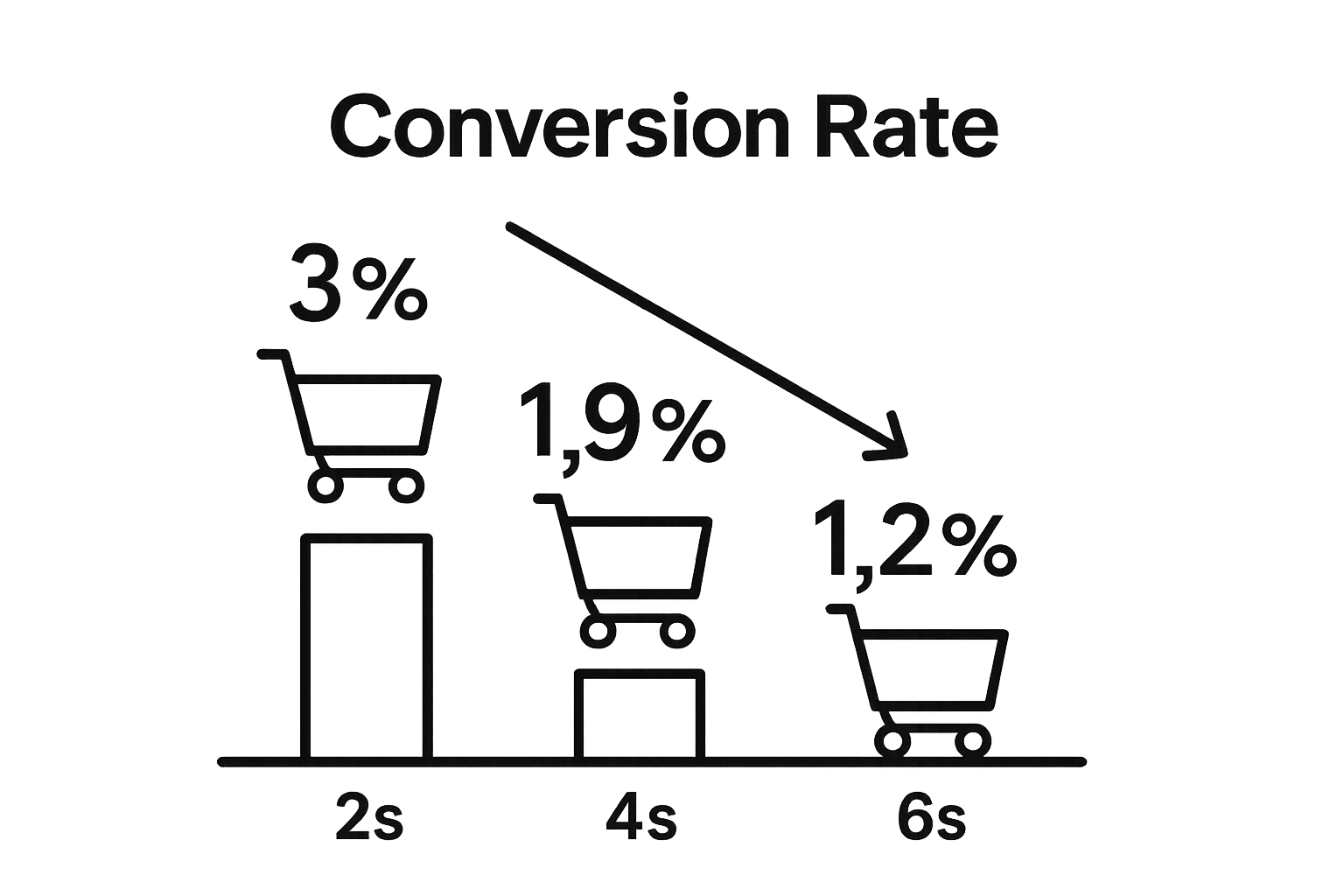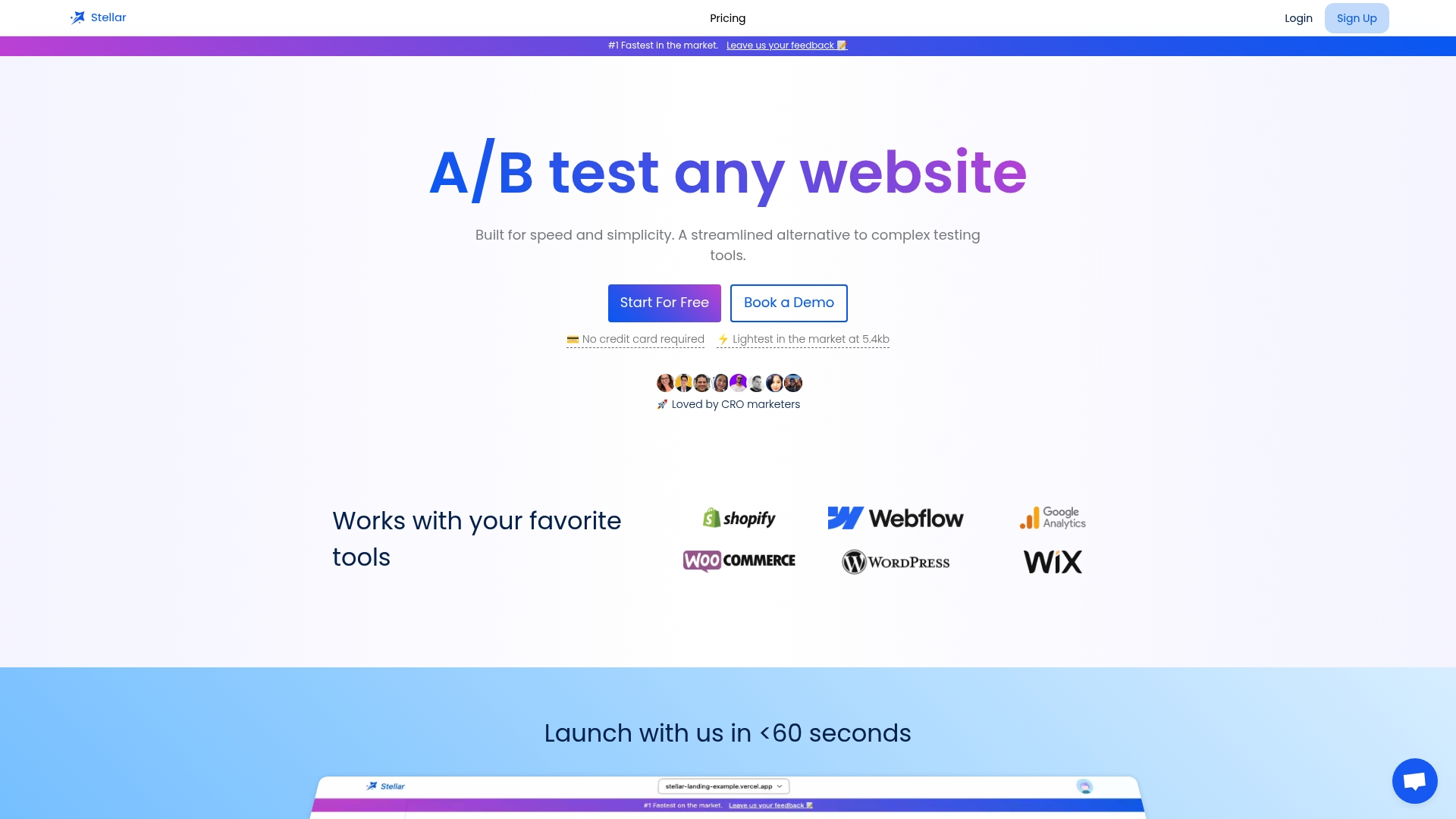
Understanding Load Time and Conversions: A Deep Dive

Website load time might only be a few seconds, but those seconds decide if your visitors stick around or disappear. Surprising, right? Even a tiny one-second delay can slash conversion rates by up to 7 percent. Smart businesses are discovering that cutting just a few seconds from load time does more for sales than the fanciest redesign or expensive ads.
Table of Contents
- What Is Load Time And Why It Matters For Conversions?
- How Load Time Influences User Experience And Decision Making
- Key Performance Indicators For Load Time And Conversions
- The Relationship Between Load Time And Sales Performance
- Real-World Examples: Load Time Effects On Conversion Rates
Quick Summary
| Takeaway | Explanation |
|---|---|
| Faster load times boost conversions | A one-second delay can reduce conversions by up to 7%, significantly impacting revenue. |
| Load time impacts user trust | Users perceive fast websites as more reliable, influencing their likelihood to stay. |
| Key metrics to monitor include FCP, TTI, and TBT | These metrics provide insights into user experience and help identify performance issues. |
| Slow speeds lead to customer abandonment | 53% of mobile users leave sites taking longer than 3 seconds to load. |
| Small improvements yield significant gains | Reducing load time can result in substantial increases in customer engagement and sales. |
What is Load Time and Why It Matters for Conversions?
Load time represents the duration between a user clicking a link or entering a website URL and the complete rendering of website content in their browser. This critical metric measures how quickly a webpage becomes fully interactive and visible to visitors. In the fast-paced digital landscape, every second counts when it comes to user engagement and conversion potential.
The Core Mechanics of Website Load Time
Load time encompasses multiple technical components that collectively determine a website's performance. These include:
- Network Request Time: How long servers take to respond to initial connection requests
- Content Download Speed: The rate at which webpage assets like images, scripts, and text are transferred
- Browser Rendering: The process of converting downloaded code into a visually complete webpage
Understanding these mechanics helps businesses recognize why load time directly impacts user experience and conversion rates. Research from the University of California, Irvine demonstrates that website speed serves as a critical signal of user trust and engagement.
Conversion Rate Impact
Users have exceptionally low tolerance for slow websites. Studies consistently show that a mere one-second delay can dramatically reduce conversion rates. Websites loading in 2.4 seconds experience significantly higher engagement compared to those requiring 4 seconds or longer.
 This performance gap translates directly into lost revenue and missed opportunities.
This performance gap translates directly into lost revenue and missed opportunities.
Businesses seeking to optimize their digital presence should read more about website performance strategies that balance speed with comprehensive user experience. By understanding load time's nuanced role, marketers and product managers can create more compelling, conversion-friendly digital environments.
How Load Time Influences User Experience and Decision Making
User experience is profoundly shaped by website performance, with load time serving as a critical psychological and technical barrier between user interest and actual engagement. When websites fail to respond quickly, users do not simply wait patiently but actively make decisions about abandoning or continuing their interaction.
Psychological Triggers of Website Performance
Website load time triggers intricate psychological responses that extend beyond mere technical measurement. Users subconsciously interpret slow loading as a signal of unreliability or poor quality. Research on web performance indicates that users form initial impressions within milliseconds, with loading speed being a primary factor in their perception of a website's credibility.
Key psychological responses include:
- Impatience Threshold: Users typically expect websites to load within 2-3 seconds
- Trust Signals: Faster websites are perceived as more professional and trustworthy
- Cognitive Load: Slow websites increase mental fatigue and decrease decision-making motivation
Decision Making and Conversion Dynamics
The relationship between load time and user decision making is direct and measurable. Websites experiencing delays risk substantial conversion losses. A one-second delay can reduce conversion rates by up to 7%, translating into significant revenue implications for businesses.
Explore advanced landing page optimization techniques to mitigate these potential losses.
Users do not merely tolerate slow websites they actively reject them. The decision to stay or leave happens instantaneously, driven by split-second assessments of website performance. Understanding these nuanced interactions allows businesses to design digital experiences that respect user time and cognitive resources.
Key Performance Indicators for Load Time and Conversions
Understanding and tracking specific performance metrics provides businesses with actionable insights into how website speed directly impacts user engagement and conversion potential. These key performance indicators serve as critical diagnostic tools for evaluating digital experience quality.
Core Load Time Performance Metrics
Effective performance measurement requires a comprehensive approach that goes beyond simple load time calculations. Research from digital performance standards highlights several crucial indicators businesses must monitor:
- First Contentful Paint (FCP): Measures the time from navigation to the first content rendering
- Time to Interactive (TTI): Tracks how long before a webpage becomes fully interactive
- Total Blocking Time (TBT): Quantifies the time a webpage is unresponsive to user interactions
These metrics provide nuanced insights into user experience beyond raw loading duration. They help identify specific performance bottlenecks that might impede smooth user interactions.
Conversion Impact Measurement
Converting technical performance data into meaningful business insights requires connecting load time metrics directly to conversion rates. Organizations must track how incremental speed improvements correlate with user behavior changes. Explore advanced conversion optimization techniques to transform performance data into strategic improvements.
Key conversion indicators include bounce rate, average session duration, and goal completion rate. By analyzing these metrics alongside load time performance, businesses can develop targeted strategies that enhance both technical performance and user experience.
The table below outlines key performance metrics and their significance for assessing website load time and user experience quality.
| Metric | Description | Why It Matters |
|---|---|---|
| First Contentful Paint (FCP) | Time from navigation to when first content appears | Indicates site appears responsive to the user |
| Time to Interactive (TTI) | Time until page is fully interactive | Shows when users can actually engage with site functionality |
| Total Blocking Time (TBT) | Total time during which the page is unresponsive | Highlights bottlenecks causing delays in interaction |
| Bounce Rate | Percentage of visitors who leave after viewing one page | Reflects potential negative impact of slow load times |
| Average Session Duration | Average length of time users stay on the site | Longer sessions often result from faster, more usable websites |
| Goal Completion Rate | Share of users who complete a specific desired action | Directly links technical performance to conversion success |
The Relationship Between Load Time and Sales Performance
Website load time is not merely a technical metric but a critical driver of sales performance across digital platforms. The connection between speed and revenue generation represents a complex interplay of user psychology, technological infrastructure, and consumer behavior.
Financial Impact of Website Speed
Research in web engineering demonstrates that website performance directly correlates with sales potential. Businesses experience tangible financial consequences when their digital platforms fail to meet user expectations for rapid, seamless interactions.
Key economic implications include:
- Immediate Revenue Loss: Slow websites can reduce conversion rates by up to 20%
- Customer Abandonment: 53% of mobile users abandon sites taking longer than 3 seconds to load
- Competitive Disadvantage: Faster websites capture a larger market share
Conversion Funnel Optimization
Load time acts as a critical gatekeeper in the sales conversion process. Every millisecond of delay represents a potential customer lost and potential revenue diminished. Learn more about optimizing conversion strategies to transform technical performance into business growth.
Successful organizations recognize that sales performance extends beyond traditional marketing tactics. By treating website speed as a strategic asset, businesses can create more responsive, user-centric digital experiences that directly translate into improved financial outcomes. The relationship between load time and sales is not linear but exponential, with small improvements generating significant economic returns.

Real-World Examples: Load Time Effects on Conversion Rates
Practical case studies reveal the profound impact of load time on digital business performance. These real-world scenarios demonstrate how incremental improvements in website speed can translate into substantial financial gains across diverse industry sectors.
E-commerce Performance Transformation
Research exploring website traffic patterns highlights the nuanced relationship between load time and conversion rates. One notable example involves an online retailer who reduced page load time from 5 to 2 seconds, resulting in a remarkable 35% increase in conversion rates and a significant boost in annual revenue.
Key transformation metrics include:
- Bounce Rate Reduction: 32% decrease in user abandonment
- Average Order Value: 22% increase in transaction size
- Customer Retention: Enhanced user experience leading to repeat purchases
Technology and User Experience Correlation
Technology giants have extensively documented the financial implications of load time. Amazon discovered that every 100 milliseconds of delay could cost them 1% in sales potential. Google similarly found that mobile sites loading within 5 seconds generate approximately twice as much revenue compared to slower counterparts. Explore advanced conversion optimization strategies to unlock similar performance improvements.
These examples underscore a fundamental truth: website performance is not just a technical metric but a critical business strategy.
The following table summarizes real-world findings on the relationship between website load time, user behavior, and sales performance for digital businesses.
| Load Time Performance | Impact on Conversion/Sales | Key Statistics |
|---|---|---|
| 1-second delay | Up to 7% decrease in conversion rate | Every 1s drop = 7% fewer conversions |
| 2.4-second load time | Significantly higher engagement rates | Higher conversions versus 4s+ load sites |
| 3+ seconds load (mobile) | Increased abandonment | 53% of mobile users leave |
| 100ms delay (Amazon) | Reduction in sales potential | Every 100ms costs approx 1% in sales |
| 5s load time (Google) | Lower revenue on mobile sites | Sites loading in 5s make 2x more than slower ones |
| 5s to 2s improvement | Raised conversion rates and average order value | Up to 35% more conversions; 22% higher order value |
| Slow load (general) | Customer abandonment, loss of market share | Competitive disadvantage |
Supercharge Your Conversions With the Fastest A/B Testing Platform
Slow website load times drain your sales and push customers away just as highlighted in our deep dive on how crucial speed is for user decision making and overall conversions. If your team struggles with sluggish landing pages or clunky testing tools that bog down performance you know how costly every lost second can be. Traditional A/B testing platforms often add excess code and complexity making it even harder to achieve lightning-fast experiences. Stellar is purpose-built to solve this very problem with a script size of only 5.4KB ensuring your site stays fast while you experiment and improve.

Ready to see how effortless optimization can transform your results? With Stellar's no-code visual editor you can launch experiments in minutes without sacrificing website speed. Instantly track impactful metrics like load time and user engagement through our real-time analytics dashboard. Visit Stellar’s homepage now and take the first step toward conversion rates that match the potential of your digital business.
Frequently Asked Questions
What is load time in website performance?
Load time refers to the duration from when a user clicks a link or enters a website URL until the complete rendering of the website content in the browser. It measures how quickly a webpage becomes fully interactive and visible to visitors.
How does load time affect conversion rates?
Research shows that even a one-second delay in load time can significantly reduce conversion rates, with websites loading in 2.4 seconds experiencing much higher engagement than those taking 4 seconds or longer. Slow websites can lead to lost revenue and missed opportunities.
What key performance metrics should be tracked for load time?
Important metrics include First Contentful Paint (FCP), Time to Interactive (TTI), and Total Blocking Time (TBT). Monitoring these indicators provides insights into user experience and identifies performance bottlenecks that need to be addressed.
How can businesses optimize their website for better load time?
Businesses can enhance their website speed by optimizing images, reducing server response time, leveraging browser caching, and utilizing content delivery networks (CDNs). These strategies help create a faster, more user-friendly digital experience.
Recommended
Published: 9/17/2025